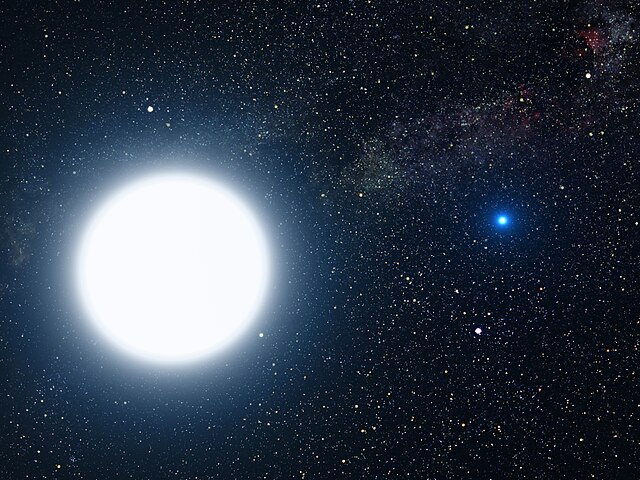
This article is motivated by the 2016 A level physics exam papers in Singapore, which has a question on the physics of binary stars.
Introduction
In the vast expanse of the universe, stars do not exist in isolation; many are part of complex gravitational systems. Among these systems, binary stars—two stars that orbit a common center of mass—are among the most fascinating celestial phenomena. Approximately half of all stars in the Milky Way galaxy are binary or multiple star systems, showcasing a diverse array of interactions and evolutionary paths. This article explores the nature of binary stars, their classifications, formation processes, significance in astrophysics, and the mysteries they reveal about the universe.
What Are Binary Stars?
Binary stars are defined as two stars that are gravitationally bound to each other. They can be identified by their shared motion through space, orbiting around a common center of mass. This relationship can take various forms, depending on the distance between the stars and their interaction dynamics.
Binary stars are classified into several categories based on their observable characteristics:
1. Visual Binaries: These are binary star systems where both stars can be distinctly seen through telescopes. Their orbits can be directly observed, allowing astronomers to calculate their masses and separations.
2. Spectroscopic Binaries: In these systems, the stars are too close together to be resolved visually. Instead, their presence is inferred through their spectral lines. As the stars move in their orbits, the Doppler effect causes shifts in the wavelengths of their spectral lines, revealing their orbital dynamics.
3. Eclipsing Binaries: This type occurs when one star passes in front of the other from our viewpoint, causing a temporary dimming of the combined light. The changes in brightness provide valuable information about the stars' sizes, masses, and orbital periods.
4. Physical Binaries: These are pairs of stars that are gravitationally bound and orbit one another. They can be either visual or spectroscopic binaries, depending on whether they can be resolved visually.
5. Hierarchical Binaries: In this arrangement, two stars form a binary system that is itself part of a larger multiple star system. This can lead to complex gravitational interactions and a rich variety of astrophysical phenomena.
Formation of Binary Stars
The formation of binary stars is a result of the processes involved in star formation within molecular clouds. When a dense region of a molecular cloud collapses under its own gravity, it can fragment into multiple clumps, each of which may form a star. In some cases, two clumps may form close enough together that they will eventually become bound to each other due to their mutual gravitational attraction.
The Role of Angular Momentum

The conservation of angular momentum plays a crucial role in the formation of binary stars. As a collapsing molecular cloud contracts, it spins faster, leading to the formation of a rotating disk. Material within this disk can coalesce to form one or more stars. If two clumps within the disk are close enough, they may begin to orbit each other, eventually forming a binary system.
The Evolution of Binary Stars
Binary stars can evolve in vastly different ways compared to single stars, largely due to their gravitational interaction. The dynamics of their orbits can influence their life cycles, leading to phenomena that single stars do not experience.
Mass Transfer and Accretion
1. Roche Lobe Overflow: In a binary system, each star has a region of space around it called the Roche lobe. When a star fills its Roche lobe, it can transfer mass to its companion. This process can lead to significant changes in the stars' structures and evolution.
2. Cataclysmic Variables: These are a type of binary star system where a white dwarf accretes material from a companion star, leading to periodic outbursts. The accretion can result in nova events, where the surface of the white dwarf ignites in a thermonuclear explosion.
3. Type Ia Supernovae: In some cases, a white dwarf in a binary system can accumulate enough mass from its companion to exceed the Chandrasekhar limit (about 1.4 solar masses). This can trigger a runaway fusion reaction, leading to a Type Ia supernova, which is crucial for measuring cosmic distances.
Common Envelope Phase
During the later stages of stellar evolution, if one star in a binary system becomes a red giant, it can engulf its companion in a phase known as the common envelope phase. In this scenario, both stars share a single outer envelope, leading to significant mass loss and changes in the orbital parameters. This process can result in the formation of close binary systems, including those that are strong sources of gravitational waves.
Determining Stellar Masses
One of the most significant contributions of binary stars to astrophysics is the ability to measure stellar masses accurately. In a binary system, the mass can be determined using Kepler’s laws of motion, which relate the orbital period of the stars to their masses and the separation between them. This allows astronomers to test models of stellar evolution and gain insights into the formation and characteristics of stars.
Understanding Stellar Evolution
Binary stars enable astronomers to study the effects of mass transfer and interaction on stellar evolution. By observing the different stages of binary star systems, scientists can gather data on how stars of varying masses evolve and interact over time. This knowledge is essential for understanding the life cycles of stars, including the mechanisms behind supernovae, neutron stars, and black holes.
Gravitational Waves
The detection of gravitational waves from merging binary systems, particularly neutron stars and black holes, has opened a new field of astrophysics. These observations provide insights into the extreme conditions of gravity and matter and allow scientists to explore the nature of spacetime itself. The study of gravitational waves from binary mergers has profound implications for our understanding of the universe’s evolution and the fundamental forces at play.
Examples of Notable Binary Star Systems
Alpha Centauri
Alpha Centauri is the closest star system to Earth and consists of three stars: Alpha Centauri A, Alpha Centauri B, and Proxima Centauri. Alpha Centauri A and B form a binary pair that orbits each other closely, while Proxima Centauri is a red dwarf star that is gravitationally bound to the system but much farther away. This system is of great interest in the search for extraterrestrial life, as Proxima Centauri hosts an Earth-sized exoplanet in its habitable zone.
Sirius
Sirius, also known as the Dog Star, is the brightest star in the night sky and a binary system composed of Sirius A, a main-sequence star, and Sirius B, a white dwarf. The two stars have a significant difference in mass and luminosity, with Sirius A being more massive and luminous than its companion. The study of Sirius B has provided crucial insights into the evolution of stars and the nature of white dwarfs.
Eta Carinae
Eta Carinae is a massive binary star system located in the Carina Nebula. It consists of two massive stars, one of which is a hypergiant, in a highly eccentric orbit. The system is known for its dramatic variations in brightness and mass loss, making it a key object of study for understanding the behavior of massive stars and the mechanisms behind supernovae.
Conclusion
Binary stars are a cornerstone of astrophysical research, providing a unique window into the processes that govern stellar evolution and the dynamics of the cosmos. Through their diverse interactions, they reveal the intricate relationships between mass, luminosity, and gravitational forces. As technology advances and our observational capabilities improve, the study of binary stars will continue to deepen our understanding of the universe, offering insights into everything from the life cycles of stars to the nature of gravitational waves.
As we gaze into the night sky and marvel at the beauty of the stars, it’s essential to remember that many of these celestial bodies are not alone; they dance together in the cosmic ballet of binary stars, enriching our understanding of the universe and our place within it.
You can learn these concepts and more at Dr Hock's maths and physics tuition.